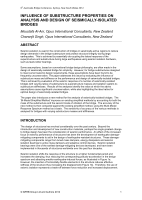Bridges

Influence of Substructure Properties on Analysis and Design of Seismically-Isolated Bridges
- Publication no: ABC-DES902-14
- Published: 22 October 2014
- PDF (free) Download
Seismic-isolation is used in the construction of bridges in seismically-active regions to reduce design demands in the bridge substructure and protect structural integrity during large earthquakes. This is achieved by essentially de-coupling the lateral response of the superstructure and substructure during large earthquakes using seismic isolation hardware, such as lead-rubber bearings.Some assumptions, based on conventional bridge design philosophy, are often made in the design of seismically-isolated bridge for simplicity. However, for bridge substructures designed to meet current seismic design requirements, these assumptions have been found to be frequently unconservative. The paper addresses this issue by evaluating the influence of substructure mass and stiffness on the performance and design of seismically-isolated bridges. This is achieved by evaluation of the seismic response of a number of seismically-isolated bridges with varying ratios of substructure-to-superstructure masses and isolation system-to-substructure stiffnesses. Results of the analyses identify the ratios at which the above assumptions cause significant unconservatism, while also highlighting the ideal ratios for optimal design of seismically-isolated bridges.The paper also introduces a new method for the analysis of seismically-isolated bridges. The Bi-Modal Simplified Method improves on existing simplified methods by accounting for both the mass of the substructure and the second mode of vibration of the bridge. The accuracy of the new method is then compared against the existing simplified method, using the Multi-Modal Response Spectrum method as a basis. The sensitivity of accuracy of the various methods is analysed for bridges with varying substructure masses and stiffnesses.
Related publications
ABC2022-110-22
Latest Bridges News
